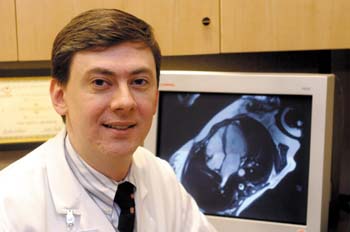
Dr. Mark Lawson is hopeful that MRI, like the image shown here, will one day replace the more invasive cardiac catheterization procedure. (photo by Dana Johnson)
MRI eyed as cardiac cath replacement
When a doctor needs to look at the heart — shape, size, squeeze, nourishment, and blood flow — cardiac catheterization is a traditional diagnostic test.
But Dr. Mark Lawson, assistant professor of Medicine and Radiology, is looking to change all of this at Vanderbilt with Magnetic Resonance Imaging, or MRI.
“The nice thing about the MRI is that it is totally safe,” Lawson said. “It is a noninvasive procedure that can be completed in 30 minutes. A patient can lie on the table, put on headphones, listen to a CD, and be done in 30 minutes.”
That is not the case with cardiac catheterization, which has small risks associated. A catheter is threaded to the heart, by way of an arterial puncture. Dye is injected through the catheter to see the heart and the arteries that nourish the heart on X-ray.
“MRI has the potential to provide a comprehensive exam in one sitting at a considerably less risk and cost to the patient,” Lawson said. But a current drawback of MRI is the inability to look at the arteries that nourish the heart. These arteries, known as the coronary arteries, become blocked with cholesterol plaque and may eventually lead to a heart attack. Lawson said the “Holy Grail” of MRI would allow doctors to view the coronary arteries noninvasively without the need for catheter insertion. This is an area of intense research.
Once coronary arteries can be visualized, MRI technology can become a “one-stop shop” for cardiovascular patients.
“Right now, in the current stage of development of MRI, the main uses include looking at the size of the heart, the structure of the heart, the squeeze of the heart, how fast blood flows, and the direction that blood flows,” Lawson said. “The name of the game for heart doctors is preserving the squeeze of the heart. Always, the treatment goals are to preserve the overall vigor of the heart.”
Lawson said the No. 1 determinant of prognosis in cardiovascular patients is being able to measure the vigor of the squeeze of the heart. “It is the one thing that the MRI can do in 15 seconds. When we see that, we can determine a patient’s outcome.”
Also, MRI is starting to be used in some emergency rooms to scan hearts of patients presenting with chest pain. Using traditional methods (EKG and blood tests), it can take up to four hours to confirm a heart attack. However with cardiac MRI, doctors can determine whether there has been heart muscle damage in just 38 minutes.
MRI is a safe test. The patient is not exposed to radiation. Instead, a magnetic field and radio waves are used to image the heart. With MRI, the heart is not obscured from view by surrounding lungs, breastbone, or the rib cage; and the heart can be viewed from any angle.
“There is a lot of potential with the cardiac MRI,” he said. Lawson, who trained in MRI at the University of Alabama at Birmingham, is directing Vanderbilt’s cardiovascular MRI efforts.













